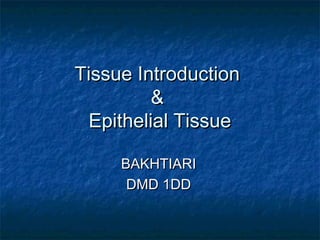Epithelialtissue 120208062655-phpapp02
- 1. Tissue Introduction & Epithelial Tissue BAKHTIARI DMD 1DD
- 2. Cells to Tissues ÔÅÆ As human body develops from single to multicellular, cells specialize. ÔÅÆ Body is interdependent system, malfunction of one group of cells is catastrophic. ÔÅÆ Cells specialize into types of tissues, then interspersed into organs.
- 3. Tissues = groups of cells that are similar in structure and function. ÔÅÆ Epithelium ÔÅÆ Muscle ÔÅÆ Coverings ÔÅÆ Movement ÔÅÆ Linings of surfaces ÔÅÆ Connective ÔÅÆ Nervous ÔÅÆ Support ÔÅÆ Control ÔÅÆ Bone, ligaments, ÔÅÆ Brain, nerves, fat spinal cord
- 4. Function of Epithelial Tissue ÔÅÆ Protection ÔÅÆ Skin protects from sunlight & bacteria & physical damage. ÔÅÆ Absorption ÔÅÆ Lining of small intestine, absorbing nutrients into blood ÔÅÆ Filtration ÔÅÆ Lining of Kidney tubules filtering wastes from blood plasma ÔÅÆ Secretion ÔÅÆ Different glands produce perspiration, oil, digestive enzymes and mucus
- 5. Characteristics of Epithelial Tissue  Form continuous sheets (fit like tiles)  Apical Surface  All epithelial cells have a top surface that borders an open space – known as a lumen  Basement Membrane  Underside of all epithelial cells which anchors them to connective tissue  Avascularity (a = without)  Lacks blood vessels  Nourished by connective tissue  Regenerate & repair quickly
- 6. Classification of Epithelial Tissue  Cell Shape  Squamous – flattened like fish scales  Cuboidal - cubes  Columnar - columns  Cell Layers  Simple (one layer)  Stratified (many layers)  Named for the type of cell at the apical surface.
- 7. Simple Squamous Epithelium  Structure  Single Layer of flattened cells  Function  Absorption, and filtration  Not effective protection – single layer of cells.  Location  Walls of capillaries, air sacs in lungs  Form serous membranes in body cavity
- 9. Simple Cuboidal Epithelium ÔÅÆ Structure ÔÅÆ Single layer of cube shaped cells ÔÅÆ Function ÔÅÆ Secretion and transportation in glands, filtration in kidneys ÔÅÆ Location ÔÅÆ Glands and ducts (pancreas & salivary), kidney tubules, covers ovaries
- 11. Simple Columnar Epithelium  Structure  Elongated layer of cells with nuclei at same level  Function  Absorption, Protection & Secretion  When open to body cavities – called mucous membranes  Special Features  Microvilli, bumpy extension of apical surface, increase surface area and absorption rate.  Goblet cells, single cell glands, produce protective mucus.  Location  Linings of entire digestive tract
- 13. Pseudostratified Epithelium  Structure  Irregularly shaped cells with nuclei at different levels – appear stratified, but aren’t.  All cells reach basement membrane  Function  Absorption and Secretion  Goblet cells produce mucus  Cilia (larger than microvilli) sweep mucus  Location  Respiratory Linings & Reproductive tract
- 15. Stratified Squamous Epithelium  Structure  Many layers (usually cubodial/columnar at bottom and squamous at top)  Function  Protection  Keratin (protein) is accumulated in older cells near the surface – waterproofs and toughens skin.  Location  Skin (keratinized), mouth & throat
- 16. Keratin Stratified Cubodial (layers of cubodial only)
- 17. Transitional Epithelium  Structure  Many layers  Very specialized – cells at base are cuboidal or columnar, at surface will vary.  Change between stratified & simple as tissue is stretched out.  Function  Allows stretching (change size)  Location  Urinary bladder, ureters & urethra


















